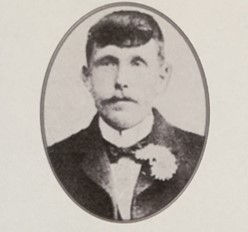Pte
Frederick Bonfield
Informations sur naissance
|
Date de naissance: 28/03/1877 |
|
Lieu de naissance: Guilden Morden, Cambridgeshire, Angleterre, Royaume-Uni |
Informations générales
|
Profession: ouvrier journalier |
Informations service militaire
|
Pays: Angleterre, Royaume-Uni |
|
Force armée: British Expeditionary Force |
|
Rang: Private |
|
Numéro de service: 37553 |
|
Incorporation nom de lieu: Bury St. Edmunds, Suffolk, Angleterre, Royaume-Uni |
|
Unités: — Bedfordshire Regiment, 4th Bn. (Dernière unité connue) |
Informations sur décès
|
Date de décès: 30/10/1917 |
|
Lieu de décès: Albatross Farm Wallemolen, Langemark Poelkapelle, Belgique |
|
Cause du décès: Killed in action (K.I.A.) |
|
Âge: 40 |
Cimetière
|
Tyne Cot Cemetery Parcelle: XIV Rangée: E Tombe: 1 |
Distinctions et médailles 2
|
British War Medal Médaille |
|
Victory Medal Médaille |
Points d'intérêt 3
| #1 | Lieu de naissance | ||
| #2 | Lieu d'enrôlement | ||
| #3 | Lieu du décès (approximatif) |
Mon histoire
Frederick Bonfield was a Farm Labourer from the village of Guilden Morden in Cambridgeshire. In February 1902 Frederick, aged 23 enlisted in the army for twelve years. He served in the Bedfordshire Regiment and was posted in South Africa in 1902-1903. Frederick married Edith Deller in Guilden Morden on 20 October 1908. After he was discharged in February 1914, Frederick went back to his hometown, where he started working as a Farm Labourer. In 1916, at the age of 39, Frederick was drafted and re-joined the Bedfordshire Regiment, 4th Battalion, part of the 190th Brigade of the 63rd Division.
In October 1917 Frederick’s Battalion took part in the Second Battle of Passchendaele. On 30 October the 63rd Division attacked from the Padebeek valley towards the heights of Westrozebeke. The 190th Brigade advanced with the 4th Bedfordshires in the centre of the divisional front, going towards Bray Farm, Banff House and Sourd Farm. The 7th Royal Fusiliers were on the left and the Artists Rifles on the right. The Canadian Corps was on the right of the Artists Rifles. The latter’s attack in the direction of Passchendaele was successful, reaching the outskirts of the village. The attack of the 63rd (Royal Naval) Division however encountered more difficulties.
The conditions on the battlefield were terrible, especially around the Paddebeek stream. The ground was sodden and in some places little more than a marsh, slowing down the advance. The advancing troops were often knee-deep in mud. Making them easy targets for the machine-gun and sniper fire from the men of the German 111th Infanterie-Division on the opposing side. While the men of the 63rd Division were struggling in the mud, the Germans dropped a counter-barrage 100 yards behind the British barrage, causing severe casualties.
That night the 63rd Division held a line at Source Trench-Varlet Farm-Bray Farm-Berks Houses, only 150-200 yards from their jump-off line. Casualties were numerous. The 4th Bedfordshires lost two officers in the attack. Seven officers were wounded. Fifty-two men were killed, 150 men were wounded and 23 men went missing. Private Frederick Bonfield, aged 40, was killed on 30 October 1917. His nephew Alfred Harold Leonard, who also served with the 4th Bedfordshires fell during the same attack. Frederick was initially buried in the field near Albatross Farm. His remains were exhumed after the war and reinterred in Tyne Cot Cemetery.
In October 1917 Frederick’s Battalion took part in the Second Battle of Passchendaele. On 30 October the 63rd Division attacked from the Padebeek valley towards the heights of Westrozebeke. The 190th Brigade advanced with the 4th Bedfordshires in the centre of the divisional front, going towards Bray Farm, Banff House and Sourd Farm. The 7th Royal Fusiliers were on the left and the Artists Rifles on the right. The Canadian Corps was on the right of the Artists Rifles. The latter’s attack in the direction of Passchendaele was successful, reaching the outskirts of the village. The attack of the 63rd (Royal Naval) Division however encountered more difficulties.
The conditions on the battlefield were terrible, especially around the Paddebeek stream. The ground was sodden and in some places little more than a marsh, slowing down the advance. The advancing troops were often knee-deep in mud. Making them easy targets for the machine-gun and sniper fire from the men of the German 111th Infanterie-Division on the opposing side. While the men of the 63rd Division were struggling in the mud, the Germans dropped a counter-barrage 100 yards behind the British barrage, causing severe casualties.
That night the 63rd Division held a line at Source Trench-Varlet Farm-Bray Farm-Berks Houses, only 150-200 yards from their jump-off line. Casualties were numerous. The 4th Bedfordshires lost two officers in the attack. Seven officers were wounded. Fifty-two men were killed, 150 men were wounded and 23 men went missing. Private Frederick Bonfield, aged 40, was killed on 30 October 1917. His nephew Alfred Harold Leonard, who also served with the 4th Bedfordshires fell during the same attack. Frederick was initially buried in the field near Albatross Farm. His remains were exhumed after the war and reinterred in Tyne Cot Cemetery.
Rapports avec d'autres militaires 1
|
Alfred Harold Leonard
Nephew |
Sources 6
|
Ancestry https://www.ancestry.co.uk/ Sources utilisées |
|
CWGC https://www.cwgc.org/find-war-dead/casualty/461984/bonfield,-/ Sources utilisées |
|
Long Long Trail http://www.longlongtrail.co.uk/army/order-of-battle-of-divisions/63rd-royal-naval-division/ Sources utilisées |
|
Maurice, F., "The 16th Foot: A History of The Bedfordshire and Hertfordshire Regiment", London, Constable and Company ltd, 1931, pg. 187-188. Sources utilisées |
|
McCarthy C., "The Third Ypres Passchendaele. The Day-by-Day Account", London, Unicorn Publishing Group, 2018, pg. 154-155. Sources utilisées |
|
War Diary http://www.nmarchive.com/ Sources utilisées |
